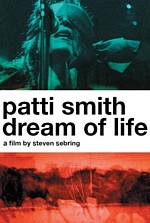
Knight at the Movies Archives
Two artful documentaries about two ground breaking artists
A pair of documentary films opening this Friday offer illuminating, intimate portraits of the lives of two extraordinary artists – the late
queer British filmmaker Derek Jarman and the still immersed up to her ears in art, rock-n-roll poet Patti Smith. The films, Derek and
Patti Smith: Dream of Life, are as individual as their subjects but both films also detail the strong artistic and personal bond between
a gay man and his female muse. In Jarman’s case it was Swinton, who first came to public attention appearing in his films. For
Smith it was photographer Robert Mapplethorpe whose iconic photographs of her helped define Smith as the high priestess of rock-n-
roll punk. Both men died of AIDS and each receives moving tributes from their surviving collaborators.
In the case of Derek Jarman, Swinton, along with director Isaac Julien, has crafted a feature length eulogy written and spoken by
her. Jarman was one of the first British artists to publicly announce his HIV status. He fought for gay rights in England both on the
picket line and through his provocative films and videos. Swinton is at turns cool and poetic as she wanders around the landmarks
that were important to the relationship and her voice is heard on the soundtrack addressing her close friend. Jarman, who began as
an art director on films, was influenced by artist David Hockney and underground gay filmmaker Kenneth Anger and was soon
making his own sensual experimental shorts that from the first featured beautiful gay men in sexual situations. Music videos for the
Smiths, the Pet Shop Boys (especially “It’s a Sin” which we see Jarman directing) and other 80s groups helped put Jarman on the
map and fund his own projects.
Swinton recalls Jarman’s loft, a sort of British version of The Factory, in which Jarman and his fellow artisans created some of their
poetic and often disturbing films. As she visits Jarman’s grave and his beachside home with its unique gardens, her memories are
illustrated by rare behind the scenes clips of Jarman in action – directing, protesting, attending a performance art exhibit of his work
(in which a pair of gay lovers lie in each others arms trapped inside a concentration camp like enclosure). He seems blissful in the
behind the scenes footage, immersed in the pleasure inherent in creating ones artwork – an ironic contrast to the tragic angst that
infuses his movies.
Derek is a beautiful elegy to a great “gay” “artist” – two words that are inextricably linked when applied to Jarman. Like Oscar Wilde,
Christopher Isherwood, Gertrude Stein, et al, his inherent gay sensibility informs his art; the work virtually drowns in it and not only
gay culture, but the world at large was great enriched by the splendor of his vision.
Derek opens exclusively in Chicago at the Gene Siskel Film Center Friday, September 26. Three of Jarman’s films, Caravaggio,
Wittgenstein, and Blue are also being shown. Showtimes and further information at www.siskelfilmcenter.com
Photographer Robert Mapplethorpe was another artist whose gay sensibility informed his work and he is given his due by his close
friend and one time roommate Patti Smith in director Steven Sebring’s Patti Smith: Dream of Life. The film, the product of a
11-year collaboration between director and subject, is a beautiful encapsulation of Smith’s extraordinary journey from her working
class, New Jersey upbringing to a rock icon (a term she says makes her feel embarrassed and think of Mt. Rushmore). Smith
herself recites the personal and creative landmarks of her life in the first four minutes of the film: the early childhood in New Jersey
(she was born in Chicago), the quick resolve to dive into nearby Manhattan, the friendship with Mapplethorpe, the poetic
collaborations with Lenny Kaye and other musicians, the landmark release of her “Horses” album in 1975 which, along with her
succeeding recordings cemented her status as the spokesperson followed by marriage to guitarist Fred Sonic Smith, retirement and
the birth of their two children. Then came the death of Mapplethorpe, her brother and husband, and a return to the rock arena.
These hallmarks out of the way the film settles into a dreamy rhythm. Sebring’s footage (both in black and white and color and
intermingled with vintage material) follows Smith as she preps for concerts, interacts with her kids and famous friends like Michael
Stipe, and Flea, performs in Japan and other places before adoring audiences, re-visits places of importance in her life – the punk
club CBGB’s, Coney Island, her home in Detroit, the gravesites of influential poets Blake and Rimbaud. A visit with her parents in
suburban New Jersey is particularly illuminating.
Smith lovingly shows off her treasures to the camera – a handmade tambourine made for her by Mapplethorpe, a favorite childhood
dress (“I can see my whole childhood in this one little dress” she says), an antique guitar that was a gift from onetime lover Sam
Shepard (who we later see dueting with her on the instrument). At one point she pours out bits of Mapplethorpe’s remains kept in a
tiny Persian urn noting that he is always with her. Smith’s observations about life, art and politics are filled with insight and not
surprisingly, everything she says has a poetic ring to it. Throughout she recites her strangely plain but beautiful poems (they match
her singing voice) in voice over. One poem, read at the memorial of Allen Ginsberg (accompanied by Philip Glass on piano) finds
Smith becoming visibly moved and is particularly effective.
The influence of Manhattan on Smith – the artist’s mecca – in light of what she has created cannot be underestimated as she herself
acknowledges at the outset (it has had a similar influence on artists as varied as Warhol and Nyro). A self-trained artist from a
working class background, the lack of creative boundaries the glittering city offered along with kindred spirits obviously inspired her.
Sebring’s greatest decision is to let the footage relate its own story. There are no talking heads, no one explaining “Patti is this” or
“Patti was that.” Slowly, a mesmerizing, complex portrait emerges.
The road an artist travels is not an easy one and Sebring and his subject often skirt the day to day realities (for years Smith was
dogged by financial problems, for example) and skips over her many personal tragedies. Instead, Patti Smith: Dream of Life focuses
on the positive and profound rewards of a life immersed in the creation of art, an exhilarating, thoughtful choice by the filmmaker, a
gift for both subject and audience. Opens Friday at Chicago's Music Box Theatre. www.musicboxtheatre.com
queer British filmmaker Derek Jarman and the still immersed up to her ears in art, rock-n-roll poet Patti Smith. The films, Derek and
Patti Smith: Dream of Life, are as individual as their subjects but both films also detail the strong artistic and personal bond between
a gay man and his female muse. In Jarman’s case it was Swinton, who first came to public attention appearing in his films. For
Smith it was photographer Robert Mapplethorpe whose iconic photographs of her helped define Smith as the high priestess of rock-n-
roll punk. Both men died of AIDS and each receives moving tributes from their surviving collaborators.
In the case of Derek Jarman, Swinton, along with director Isaac Julien, has crafted a feature length eulogy written and spoken by
her. Jarman was one of the first British artists to publicly announce his HIV status. He fought for gay rights in England both on the
picket line and through his provocative films and videos. Swinton is at turns cool and poetic as she wanders around the landmarks
that were important to the relationship and her voice is heard on the soundtrack addressing her close friend. Jarman, who began as
an art director on films, was influenced by artist David Hockney and underground gay filmmaker Kenneth Anger and was soon
making his own sensual experimental shorts that from the first featured beautiful gay men in sexual situations. Music videos for the
Smiths, the Pet Shop Boys (especially “It’s a Sin” which we see Jarman directing) and other 80s groups helped put Jarman on the
map and fund his own projects.
Swinton recalls Jarman’s loft, a sort of British version of The Factory, in which Jarman and his fellow artisans created some of their
poetic and often disturbing films. As she visits Jarman’s grave and his beachside home with its unique gardens, her memories are
illustrated by rare behind the scenes clips of Jarman in action – directing, protesting, attending a performance art exhibit of his work
(in which a pair of gay lovers lie in each others arms trapped inside a concentration camp like enclosure). He seems blissful in the
behind the scenes footage, immersed in the pleasure inherent in creating ones artwork – an ironic contrast to the tragic angst that
infuses his movies.
Derek is a beautiful elegy to a great “gay” “artist” – two words that are inextricably linked when applied to Jarman. Like Oscar Wilde,
Christopher Isherwood, Gertrude Stein, et al, his inherent gay sensibility informs his art; the work virtually drowns in it and not only
gay culture, but the world at large was great enriched by the splendor of his vision.
Derek opens exclusively in Chicago at the Gene Siskel Film Center Friday, September 26. Three of Jarman’s films, Caravaggio,
Wittgenstein, and Blue are also being shown. Showtimes and further information at www.siskelfilmcenter.com
Photographer Robert Mapplethorpe was another artist whose gay sensibility informed his work and he is given his due by his close
friend and one time roommate Patti Smith in director Steven Sebring’s Patti Smith: Dream of Life. The film, the product of a
11-year collaboration between director and subject, is a beautiful encapsulation of Smith’s extraordinary journey from her working
class, New Jersey upbringing to a rock icon (a term she says makes her feel embarrassed and think of Mt. Rushmore). Smith
herself recites the personal and creative landmarks of her life in the first four minutes of the film: the early childhood in New Jersey
(she was born in Chicago), the quick resolve to dive into nearby Manhattan, the friendship with Mapplethorpe, the poetic
collaborations with Lenny Kaye and other musicians, the landmark release of her “Horses” album in 1975 which, along with her
succeeding recordings cemented her status as the spokesperson followed by marriage to guitarist Fred Sonic Smith, retirement and
the birth of their two children. Then came the death of Mapplethorpe, her brother and husband, and a return to the rock arena.
These hallmarks out of the way the film settles into a dreamy rhythm. Sebring’s footage (both in black and white and color and
intermingled with vintage material) follows Smith as she preps for concerts, interacts with her kids and famous friends like Michael
Stipe, and Flea, performs in Japan and other places before adoring audiences, re-visits places of importance in her life – the punk
club CBGB’s, Coney Island, her home in Detroit, the gravesites of influential poets Blake and Rimbaud. A visit with her parents in
suburban New Jersey is particularly illuminating.
Smith lovingly shows off her treasures to the camera – a handmade tambourine made for her by Mapplethorpe, a favorite childhood
dress (“I can see my whole childhood in this one little dress” she says), an antique guitar that was a gift from onetime lover Sam
Shepard (who we later see dueting with her on the instrument). At one point she pours out bits of Mapplethorpe’s remains kept in a
tiny Persian urn noting that he is always with her. Smith’s observations about life, art and politics are filled with insight and not
surprisingly, everything she says has a poetic ring to it. Throughout she recites her strangely plain but beautiful poems (they match
her singing voice) in voice over. One poem, read at the memorial of Allen Ginsberg (accompanied by Philip Glass on piano) finds
Smith becoming visibly moved and is particularly effective.
The influence of Manhattan on Smith – the artist’s mecca – in light of what she has created cannot be underestimated as she herself
acknowledges at the outset (it has had a similar influence on artists as varied as Warhol and Nyro). A self-trained artist from a
working class background, the lack of creative boundaries the glittering city offered along with kindred spirits obviously inspired her.
Sebring’s greatest decision is to let the footage relate its own story. There are no talking heads, no one explaining “Patti is this” or
“Patti was that.” Slowly, a mesmerizing, complex portrait emerges.
The road an artist travels is not an easy one and Sebring and his subject often skirt the day to day realities (for years Smith was
dogged by financial problems, for example) and skips over her many personal tragedies. Instead, Patti Smith: Dream of Life focuses
on the positive and profound rewards of a life immersed in the creation of art, an exhilarating, thoughtful choice by the filmmaker, a
gift for both subject and audience. Opens Friday at Chicago's Music Box Theatre. www.musicboxtheatre.com
Ground Breakers:
Derek-Patti Smith: Dream of Life
Expanded Edition of 9-24-08 Knight at the Movies Column
By Richard Knight, Jr.
Derek-Patti Smith: Dream of Life
Expanded Edition of 9-24-08 Knight at the Movies Column
By Richard Knight, Jr.


